There are 20 species of turtles in New York state, although not all of these are native species. Across the Empire State there are 12 native species including terrestrial turtles such as Eastern Box turtles and fully aquatic species such as the Common Snapping turtle, which is New York’s official state reptile.
There are also three non-native species that have colonized New York state over the years; the Northern Red-bellied Cooter, Red-eared Sliders, and Yellow-bellied Sliders. There are also five species of Sea turtles that can be spotted off the coastline. Reports of mutant ninja turtles in the sewers of New York City remain unconfirmed…
This list can be used as both a field herping guide and a reference list for anyone looking to choose one of New York’s turtles as their next pet. Keep in mind that within New York state itself, every single native species aside from Common Snapping turtles are protected and cannot be owned, sold, or taken from the wild.
If you live outside of New York state, check your home state’s laws before choosing one of these turtles. If you can, try and adopt a turtle from an animal shelter first. If you have to purchase a turtle, please only buy captive-bred specimens from registered breeders wherever possible.
Now, without further ado, let’s dive into the 20 species of turtles in New York state.
Turtles in New York State
1. Blanding’s Turtle

- Experience Level: Intermediate
- Family: Emydidae
- Scientific Name: Emydoidea blandingii
- Other Names: N/A
- Adult Size: 5 to 8 inches (12.5 to 20 cm)
- Lifespan: Up to 80 years
- Average Price Range: $300 to $450
Named after naturalist William Blanding, these semi-aquatic turtles are threatened in New York thanks to habitat destruction. There are scattered populations of Blanding’s turtles across the state, concentrated mainly in the northern counties in marshy areas.
Blanding’s turtles have dark oval shells covered in yellow speckles. Their plastrons are yellow with black patches and they also have yellow throats. They are cautious, often diving to safety at any sign of trouble.
Blanding’s turtles are omnivorous, mainly eating crustaceans, insects, and mollusks. They will also occasionally eat plants.
2. Bog Turtle

- Experience Level: Beginner
- Family: Emydidae
- Scientific Name: Glyptemys muhlenbergii
- Other Names: Muhlenberg’s turtle
- Adult Size: 3.5 to 5 inches (9 to 12.5 cm)
- Lifespan: Up to 40 years
- Average Price Range: $250 to $450
Bog turtles are the smallest turtle species in North America and are a Critically Endangered species. In New York, they are found in both southern and a few central counties. They inhabit wetland regions such as bogs or swamps.
Also known as Muhlenberg’s turtle, Bog turtles have keeled shells that range from olive or dark brown to black. Some of the scutes may have yellow or red star-like patterning. They are diurnal turtles and are most active during the warmest parts of the day.
Bog turtles are omnivores and mainly eat insects and mollusks along with occasional pieces of vegetation.
3. Eastern Box Turtle

- Experience Level: Beginner
- Family: Emydidae
- Scientific Name: Terrapene carolina carolina
- Other Names: Common Box turtle, Land turtle
- Adult Size: 4 to 7 inches (10 to 18 cm)
- Lifespan: Up to 40 years
- Average Price Range: $120 to $400
Eastern Box turtles are a mainly terrestrial species that inhabit grassland and woodland regions that have water sources such as ponds. They are commonly found in the southern and southwestern areas of New York.
Eastern Box turtles have highly domed dark brown shells with distinctive yellow and orange stripe or dot markings. Their plastrons are also dark brown and they have brown skin with more orange markings. Males have concave plastrons while those on females are flat.
These terrestrial turtles can roam up to 50 meters a day in search of food for their omnivorous diet, which usually consists of small fish, insects, and fruits and plant matter.
4. Northern Diamondback Terrapin

- Experience Level: Beginner to Intermediate
- Family: Emydidae
- Scientific Name: Malaclemys terrapin terrapin
- Other Names: Diamond-backed terrapin
- Adult Size: 4.5 to 9 inches (11.5 to 23 cm)
- Lifespan: 25 to 40 years
- Average Price Range: $250 to $300
Northern Diamondback terrapins are aquatic turtles that favor the brackish waters and tidal marshes of New York’s coastal and estuary regions. They are found mainly in the extreme southeastern regions around New York City and Long Island.
Northern Diamondback terrapins have distinctive gray skin with black speckled markings and thick webbed feet on their hind limbs. Their shells range from black to brown to gray, with concentric rings on their scutes.
These Diamondback terrapins feed on crustaceans, insects, mollusks, and shellfish such as clams or winkles. They will also occasionally eat vegetation. They can often be seen swimming in the water with their heads poking out, similar to periscopes.
5. Common Map Turtle
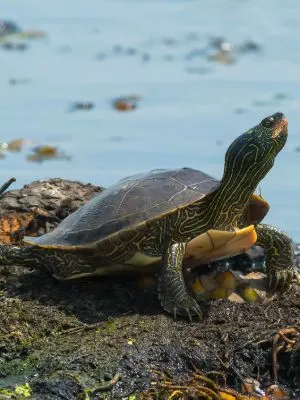
- Experience Level: Beginner
- Family: Emydidae
- Scientific Name: Graptemys geographica
- Other Names: Northern Map turtle
- Adult Size: 4 to 10.5 inches (10 to 26.5 cm)
- Lifespan: 15 to 20 years
- Average Price Range: $20 to $60
Common Map turtles are found in many of New York’s major river systems such as the Hudson. They are an aquatic species that rarely venture far from the water and are fantastic swimmers. They can be seen basking frequently at the water’s edge.
Common Map turtles have dark brown or olive green shells that are covered with yellowish lines that resemble the contours of a map. Small yellow spots behind the eyes separate the Common Map turtle from other subspecies.
These turtles are mainly carnivorous, feeding on crustaceans, fish, and insects. They might occasionally eat aquatic vegetation.
6. Eastern Mud Turtle
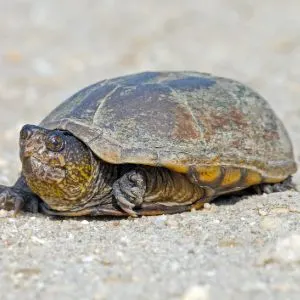
- Experience Level: Beginner
- Family: Kinosternidae
- Scientific Name: Kinosternon subrubrum
- Other Names: Common Mud turtle
- Adult Size: 3 to 5 inches (7.5 to 12.5 cm)
- Lifespan: Up to 50 years
- Average Price Range: $40 to $100
Eastern Mud turtles are small aquatic turtles found in a few isolated populations on Long Island and the areas surrounding New York City. They inhabit shallow, slow-moving but clear waters such as bogs or swamps.
Eastern Mud turtles have smooth, oval-shaped carapaces that have a gradual slope at the front but drop quite sharply at the sides and back and range from brown to green to yellowish in color. They have large plastrons for their size, which are usually brown to yellowish-brown. They have mottled dark patterns on their grayish throats.
This species of Mud turtle is omnivorous and mainly eat small fish and mollusks but will also sometimes consume plant material.
7. Common Musk Turtle

- Experience Level: Intermediate
- Family: Kinosternidae
- Scientific Name: Sternotherus odoratus
- Other Names: Eastern Musk turtle, Stinkpot
- Adult Size: 4 to 5 inches (10 to 12.5 cm)
- Lifespan: 50+ years
- Average Price Range: $20 to $90
Common Musk turtles are a small aquatic species that are also know as “Stinkpots” thanks to the powerful odor that they can release from their musk glands when threatened. These turtles can be found scattered across New York state, with most specimens concentrated in southeastern areas around the Hudson River.
Common Musk turtles have black to dark brown to gray-green unmarked shells. Their slightly pointed heads are also dark with two yellowish stripes on their long necks. Fleshy barbels are present on both their chins and throats.
These small turtles are nocturnal omnivores that mainly eat small amphibians, crustaceans, and mollusks. Common Musk turtles inhabit boggy or marshy habitats with clear, slow-moving waters.
8. Painted Turtles
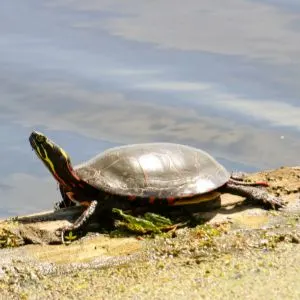
- Experience Level: Beginner
- Family: Emydidae
- Scientific Name: Chrysemys picta picta (Eastern), Chrysemys picta marginata (Midland)
- Other Names: N/A
- Adult Size: 4 to 10 inches (10 to 25.5 cm)
- Lifespan: 30 to 50 years
- Average Price Range: $20 to $50
New York State is home to two subspecies of Painted turtles – Eastern Painted turtles, which are found in central and southeastern regions of the state, and Midland Painted turtles that inhabit everywhere else, including central, northern, and western counties. These aquatic turtles prefer shallow waters such as marshes and ponds.
Painted turtles have black or dark brown shells and tan to yellowish plastrons. Their faces and throats have yellow stripe markings. It’s often difficult to separate Eastern and Midland Painted turtles, but Midland specimens will have a dark, shadow-like patch in the center of their plastrons.
These diurnal turtles can often be seen basking on logs beside the water. Both subspecies are omnivores. Eastern Painted turtles prefer consuming small fish and plants, whilst Midland Painted turtles mainly eat insects and vegetation.
9. Common Snapping Turtle

- Experience Level: Intermediate to Expert
- Family: Chelydridae
- Scientific Name: Chelydra serpentina
- Other Names: Common Snapper, Eastern Snapping turtle, Snapper
- Adult Size: 8 to 20 inches (20 to 51 cm)
- Lifespan: 30 to 50 years
- Average Price Range: $20 to $40
Common Snapping turtles are a large, freshwater species that are widespread across most of New York. They are also the Empire State’s official state reptile and are the only unprotected native species in New York. Although they can be legally kept as pets, their large size and potentially aggressive nature make them suitable only for intermediate or expert keepers.
Common Snappers are famous for their intimidating appearance. They have powerful, hooked beak-like jaws, strong claws, and long tails covered with saw-toothed spines. Their thick shells are dark brown or green, with three prominent ridges in the center.
These large aquatic turtles are nocturnal omnivores and will eat whatever they can catch. They usually consume amphibians, fish, smaller turtles, and waterbirds. They may also occasionally eat aquatic vegetation.
10. Eastern Spiny Softshell Turtle
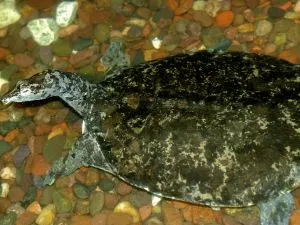
- Experience Level: Intermediate to Expert
- Family: Trionychidae
- Scientific Name: Apalone spinifera
- Other Names: N/A
- Adult Size: 5 to 17 inches (12.5 to 43 cm)
- Lifespan: 20 to 50 years
- Average Price Range: $70 to $280
Eastern Spiny Softshells are found in a few of New York’s western counties. They are fast swimmers that prefer rivers or streams with moving currents. They require sandbars in their habitats for hunting and nesting.
Eastern Spiny Softshells have leathery pancake-shaped shells that lack a hard carapace. They have dark spots on their shells along with a row of small spines towards the front edge of the carapace. They also have long, tapered snouts which they use to breathe while buried in the sand.
These medium-sized Spiny Softshells are carnivores and will consume any crustaceans, fish, insects, or mollusks that swim past their hiding place. They lunge forwards and grab their prey between their jaws.
11. Spotted Turtle

- Experience Level: Intermediate to Expert
- Family: Emydidae
- Scientific Name: Clemmys guttata
- Other Names: N/A
- Adult Size: 4 to 5 inches (10 to 12.5 cm)
- Lifespan: 25 to 50 years
- Average Price Range: $75 to $100
Spotted turtles are a semi-aquatic species that is fairly widespread across New York. Most populations are centered around the western counties that border Lake Ontario along with southeastern areas above and including Long Island and New York City. These small turtles prefer shallow waters in boggy and marshy habitats.
Spotted turtles have smooth black shells that are covered with their beautiful eponymous bright yellow spots. Their plastrons are yellow with large black patches of varying sizes on either side and they have fairly long tails.
This Special Concern species eats an omnivorous diet of crustaceans, insects, and mollusks alongside occasional plant matter.
12. Wood Turtle

- Experience Level: Intermediate
- Family: Emydidae
- Scientific Name: Glyptemys insculpta
- Other Names: N/A
- Adult Size: 5.5 to 8 inches (14 to 20 cm)
- Lifespan: 40 to 60 years
- Average Price Range: $250 to $500
Wood turtles are an Endangered species that has been spotted across most regions of New York. These intelligent, largely terrestrial turtles prefer woodland habitats with shallow, slow-moving ponds and streams that have sandy bottoms.
Wood turtles get their name from their dark brown shells, which have a rough feel and resemble a sculpted piece of wood. Patterns that look like growth rings and wood grain are found on their shells. Their scutes can sometimes have the appearance of pyramiding.
These diurnal omnivores roam widely as they forage for food, mainly eating berries, plants, insects, and mollusks. They will sometimes stomp their feet on the ground to trick earthworms into surfacing.
New York has also seen the rapid spread of three non-native turtle species in recent years; Northern Red-bellied Cooters, Red-eared Sliders, and Yellow-bellied Sliders. Non-native species are not regulated in terms of ownership laws like native turtles, but even though unsafe release is prohibited, these three species have likely been irresponsibly released from captivity into the state.
13. Northern Red-bellied Cooter

- Experience Level: Beginner to Intermediate
- Family: Emydidae
- Scientific Name: Pseudemys rubriventris
- Other Names: American Red-bellied turtle, Northern Redbelly Cooter
- Adult Size: 8 to 12.5 inches
- Lifespan: 40 to 55 years
- Average Price Range: $30 to $170
Northern Red-bellied Cooters are North America’s largest pond turtles and are not native to New York. They have so far been reported in areas around New York City as well as occasional sightings in central counties. They mainly inhabit rivers and ponds with soft bottoms and can sometimes be found in brackish waters.
Northern Red-bellied Cooters are easily identified by their eponymous red colored plastrons, and they also have reddish lines on some of the scutes of their black to olive green shells. They also have yellowish markings on their skin.
These Cooters are omnivorous and mainly feeding on insects and mollusks, although adults may also consume a lot of vegetation.
14. Red-eared Slider

- Experience Level: Beginner
- Family: Emydidae
- Scientific Name: Trachemys scripta elegans
- Other Names: Red-eared Terrapin, Water Slider turtle
- Adult Size: 6 to 8 inches (15 to 20 cm)
- Lifespan: 20 to 40 years
- Average Price Range: $15 to $50
Red-eared Sliders are a popular species in the pet trade that unfortunately often get released unsafely by unprepared owners. These turtles can quickly overpower native turtles in new areas and have become an infestation in the ponds at Central Park and other outdoor spaces in New York City. They can also be found scattered across the rest of the state.
Red Eared Sliders have olive green shells with yellowish striped markings on their scutes. Their heads are usually a darker color, with yellow band markings and the eponymous red patches just behind their eyes.
These semi-aquatic turtles prefer warm, slow-moving waters such as rivers and lakes. They eat an omnivorous diet consisting of small fish, insects, and aquatic vegetation.
15. Yellow-bellied Slider
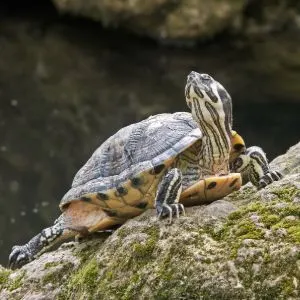
- Experience Level: Beginner
- Family: Emydidae
- Scientific Name: Trachemys scripta scripta
- Other Names: N/A
- Adult Size: 5 to 12 inches (12.5 to 30.5 cm)
- Lifespan: 20 to 40 years
- Average Price Range: $15 to $50
Yellow-bellied Sliders are another non-native species that has started to encroach on New York state. They are an unregulated species and are often unsafely released from captivity by unprepared owners. So far, only a few sightings have been reported in small pockets around New York City and Long Island.
As their name implies, Yellow-bellied Sliders have yellowish plastrons as well as yellow markings across their skin. These aquatic turtles also have prominent yellow stripes behind their eyes. Their shells range from dark brown to olive.
Yellow-bellied Sliders prefer rivers and lakes in wetland habitats. They are diurnal omnivores that mainly consume aquatic vegetation as well as small amphibians and fish, insects, and mollusks.
There are also five species of Sea turtles that can be spotted in the waters off the coastlines of New York. All of these species are Endangered or Critically Endangered and cannot be kept as pets under any circumstances. Below, we’ll give some brief facts about each species as well as a link to a dedicated page for more information.
Sea Turtles in New York
16. Green Sea Turtle
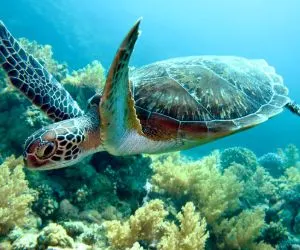
- Family: Cheloniidae
- Scientific Name: Chelonia mydas
- Other Names: N/A
- Adult Size: 3 to 4 feet (90 to 120 cm)
- Weight: 300 to 400 lbs (135 to 180 kg)
- Lifespan: 80 to 100 years
- Conservation Status: Endangered
- Habitat: Bays and shores along coastlines and open ocean waters, seen during summer months
- Clutch Size: Around 110 to 115 eggs, with 2 to 5 clutches per breeding season
- Food: Mostly herbivores, eating algae, sea grasses and seaweed
- Appearance: Smooth green to brown shells shaped like hearts, edged in yellow. Cream colored scaly skin with shades of green
Head to our Green Sea turtles page for more information.
17. Hawksbill Sea Turtle
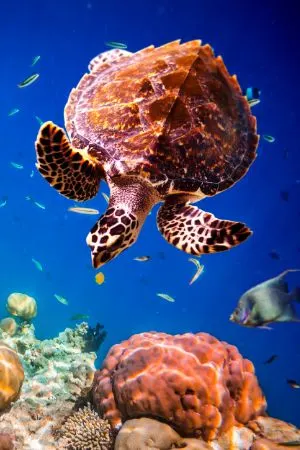
- Family: Cheloniidae
- Scientific Name: Eretmochelys imbricata
- Other Names: Atlantic Hawksbill turtle
- Adult Size: 30 to 35 inches (76 to 89 cm)
- Weight: 100 to 155 lbs (45 to 70 kg)
- Lifespan: 30 to 50 years
- Conservation Status: Critically Endangered
- Habitat: Shallow coastal areas of rocky or tropical waters, reefs and estuaries
- Clutch Size: Between 140 to 200 eggs, about 4 clutches per breeding season
- Food: Omnivores, mainly consuming crustaceans, mollusks, and algae
- Appearance: Prominent, beak-shaped mouths (like a hawk), oval shells in shades of amber with unique markings. Flippers also have claws at their “elbows”
For more information, check out our Hawksbill Sea turtle page.
18. Kemp’s Ridley Sea Turtle
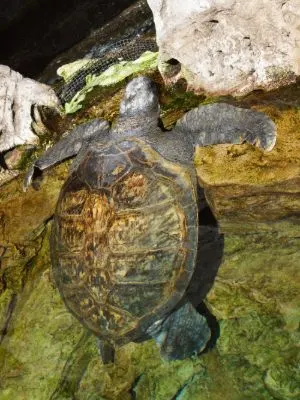
- Family: Cheloniidae
- Scientific Name: Lepidochelys kempii
- Other Names: Atlantic Ridley Sea turtle
- Adult Size: Around 25 inches (63.5 cm)
- Weight: 75 to 100 lbs (34 to 45 kg)
- Lifespan: Around 30 years
- Conservation Status: Critically Endangered
- Habitat: Sandy or muddy coastlines with shallow waters
- Clutch Size: Between 100 and 110 eggs, 2 to 3 clutches per breeding season
- Food: Crustaceans, shellfish
- Appearance: Slightly hooked beaks, triangle-shaped heads. Green to gray round shells. Muted cream or yellow plastrons and undersides.
Visit our Ridley sea turtle page for more information.
19. Leatherback Turtle

- Family: Dermochelyidea
- Scientific Name: Dermochelys coriacea
- Other Names: N/A
- Adult Size: 6 to 7 feet (182 to 213 cm)
- Weight: 1200 to 1450 lbs (545 to 658 kg)
- Lifespan: Around 30 years
- Conservation Status: Vulnerable
- Habitat: Warm waters, mainly shallow, calm bays or lagoons. Nests common on sandy beaches.
- Clutch Size: Between 100 and 110 eggs
- Food: Jellyfish is the staple of their diet, but they will also eat other sea creatures
- Appearance: Their large carapaces are soft, unique among sea turtles, with prominent ridges all the way down. Colors vary between black and a dark gray.
For more information, see our Leatherback sea turtle page.
20. Loggerhead Sea Turtle

- Family: Cheloniidae
- Scientific Name: Caretta caretta
- Other Names: N/A
- Adult Size: 30 to 45 inches (76 to 114 cm)
- Weight: Approximately 155 pounds (70 kg)
- Lifespan: 70 to 80 years
- Conservation Status: Endangered
- Habitat: Coastal regions, mainly shallow bays. Prefer sub-tropical waters. Sandy ocean beaches for nesting
- Clutch Size: Between 100 and 125 eggs, 4 to 5 clutches per breeding season
- Food: Carnivorous, mainly eating shellfish, mollusks, and crustaceans
- Appearance: Largest hard-shelled turtles with a reddish-brown carapace and large heads. Undersides are cream to yellowish. Long powerful flippers
Check out our Loggerhead sea turtle page for more information.
Frequently Asked Questions about New York Turtles
What kind of turtles live in New York?
New York state is home to 20 species of turtle. There are 12 native freshwater & brackish water species, ranging from the terrestrial Eastern Box turtle to the Northern Diamondback terrapin that prefers brackish waters. There are also several aquatic and semi-aquatic species such as Common Snapping turtles, which are the official State reptile, and species such as Blanding’s and Spotted turtles.
Three non-native species have also begun to colonize parts of the state, including Northern Red-bellied Cooters, Red-eared Sliders, and Yellow-bellied Sliders. Off the coast of New York, you may also be lucky enough to spot specimens from five species of Sea turtles such as Atlantic Ridley turtles and Green Sea turtles.
Are turtles illegal in New York?
It is illegal to possess, sell, or import any of New York’s native turtle species apart from Common Snapping turtles. All of the other native turtles in New York are classed as Protected Species. You are also prohibited from capturing and taking any of these species from the wild apart from Common Snappers.
It is legal to both possess and hunt Common Snapping turtles in New York state, although hunting them requires a hunting license. Snappers may only be hunted from mid-July to the end of September and must have a minimum carapace length of 12 inches to qualify for legal capture.
There are no possession or sale laws governing non-native turtles such as Red-eared Sliders. However, you are prohibited from releasing them into the wild, although this hasn’t stopped some irresponsible owners.
Conclusion
Well, that wraps up our list of the 20 types of turtles in New York state. We’ve covered New York’s 12 native species along with three non-native turtles and the five types of Sea turtles that can be spotted in New York’s coastal waters.
This list is best used as a field herping guide. We’ve also explored the laws governing the possession of turtles in New York state, so please abide by these laws and respect New York’s native species.
If you enjoyed this list, feel free to comment down below and discuss the turtles of New York with your fellow herping enthusiasts!
Other nearby states
- Turtles in Connecticut
- Turtles in Europe
- Turtles in New Jersey
- Turtles in Pennsylvania
- Turtles in Rhode Island
